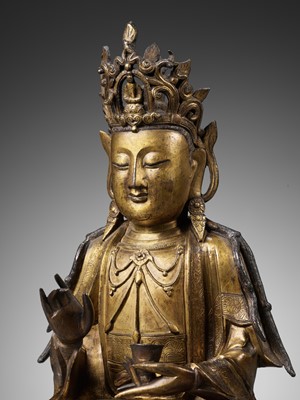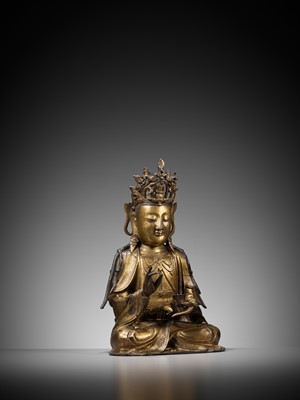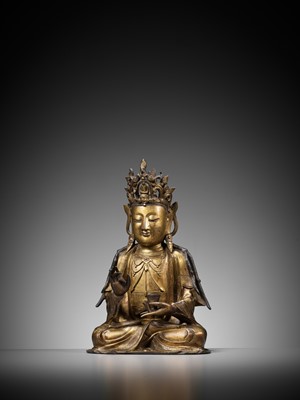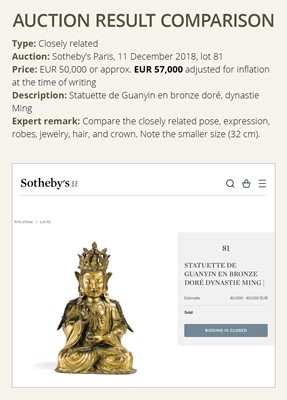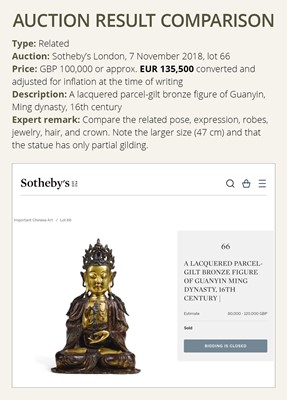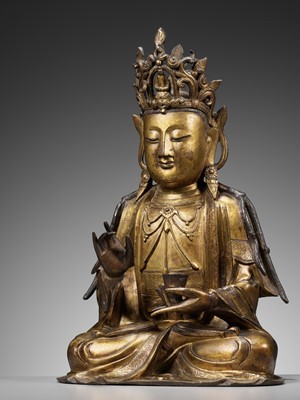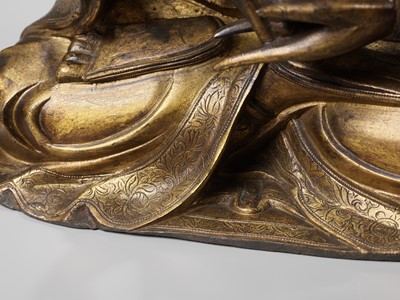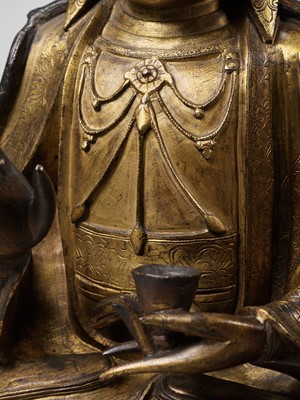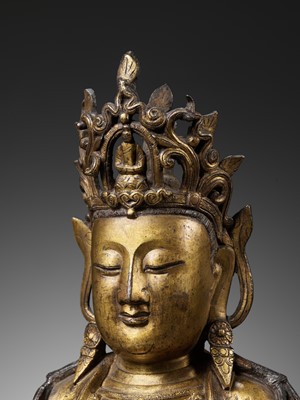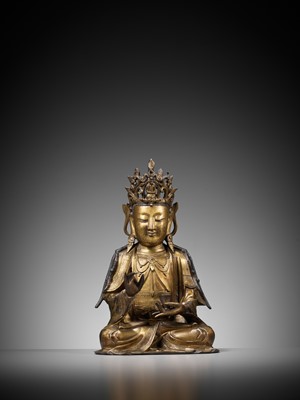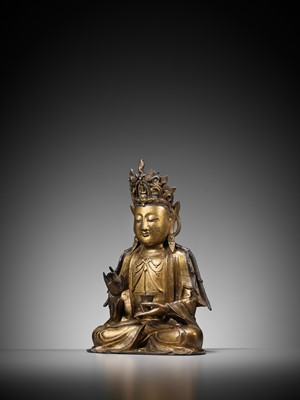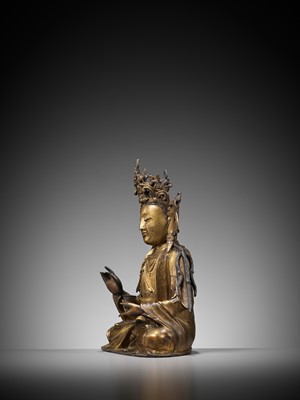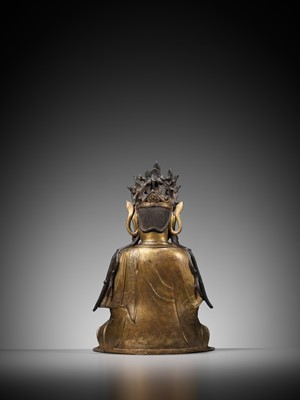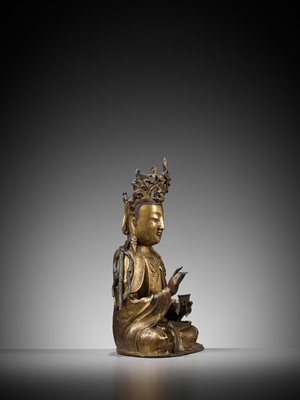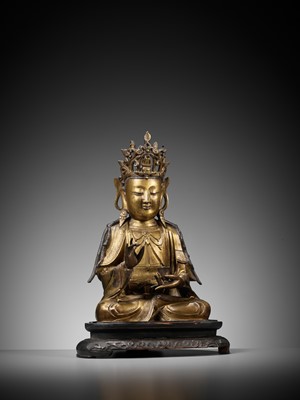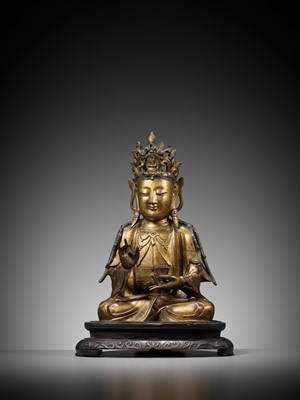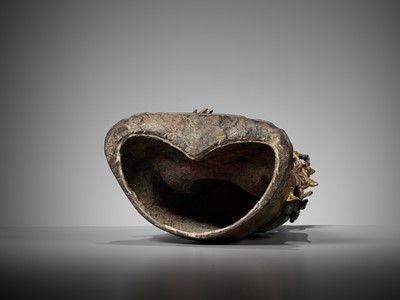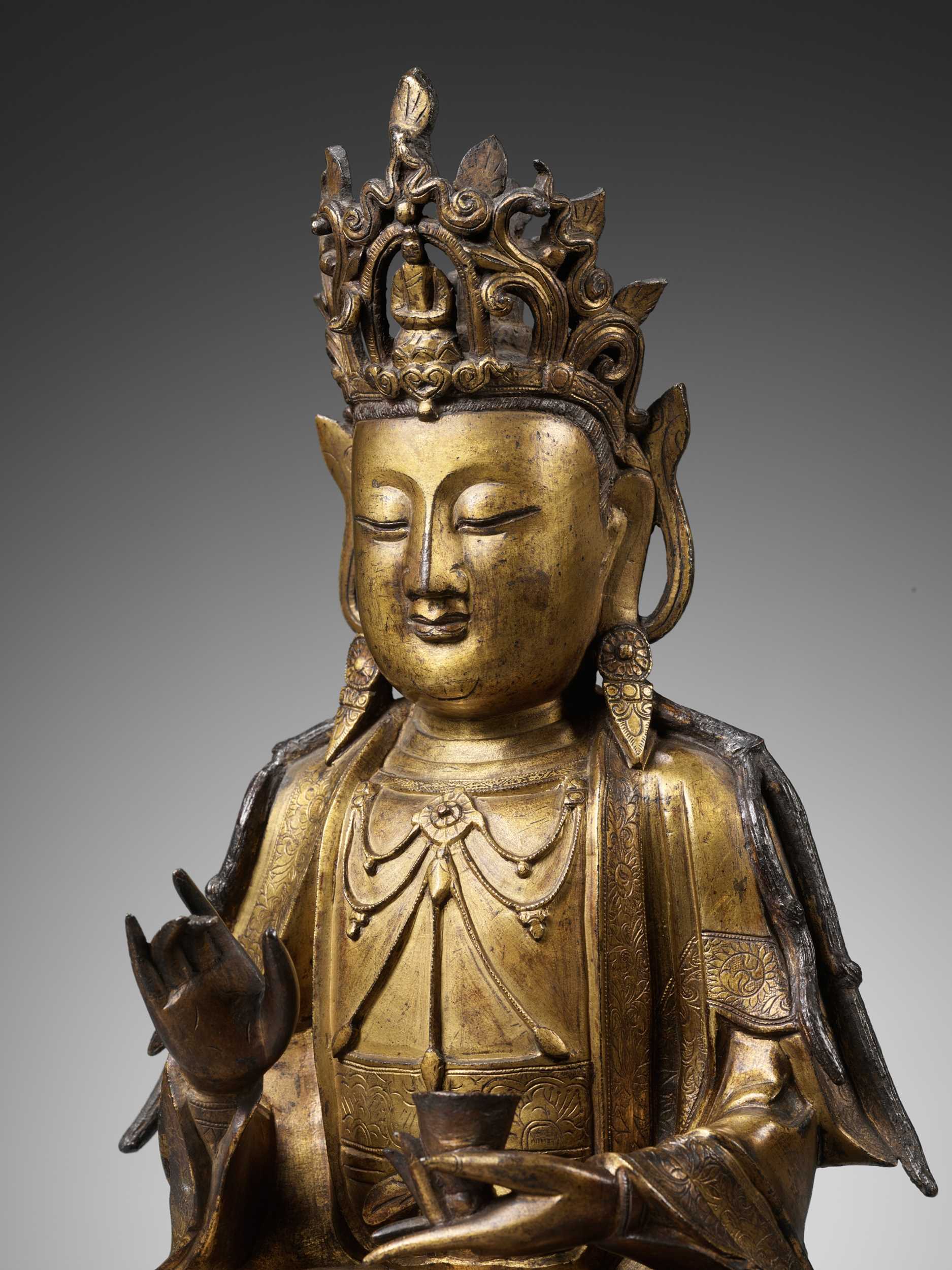29th Sep, 2022 13:00
DAY 1 - TWO-DAY AUCTION - Fine Chinese Art / 中國藝術集珍 / Buddhism & Hinduism
172
A LARGE GILT BRONZE ‘WILLOW LEAF’ GUANYIN, BHAISAJYARAJA AVALOKITESHVARA, MING DYNASTY
明代大型楊柳觀音鎏金銅像
Sold for €49,400
including Buyer's Premium
China, 16th century. Finely cast seated in dhyanasana, the hands held in karana mudra, her left holding a bowl of elixir. She is wearing long flowing robes with well carved folds and neatly incised floral hems, and is richly adorned with fine jewelry. Her serene face with heavy-lidded downcast eyes and full lips forming a subtle smile, flanked by long pendulous earlobes suspending elaborate earrings.
Provenance: From an old private collection in Paris, France, and thence by descent. French trade, acquired from the above.
Condition: Superb condition. Some old wear, minor casting flaws, few minuscule nicks and light scratches. The gilt is well-preserved overall. The separately cast willow twig in her right is lost. Note that all exposed areas, and particularly the delicate crown, show no losses or signs of repair whatsoever. Fine, naturally grown patina. A 16th-century gilt-bronze figure in such magnificent condition is extremely rare.
Weight: 6,729 g (excl. stand)
Dimensions: Height 36 cm (excl. stand) and 41 cm (incl. base)
The neatly incised hair falling elegantly in strands over the shoulders and tied up into a high chignon behind the open worked foliate crown centered by a small image of the Buddha Amitabha.
With an old fitted wood base dating from the Qing dynasty. (2)
According to the Lotus Sutra, Avalokiteshvara can take any form necessary to save sentient beings. Thirty-three manifestations of Avalokiteshvara are mentioned and are known to have been very popular in Chinese Buddhism as early as the Sui and Tang Dynasties. The present lot depicts the bodhisattva in a manifestation known as Bhaisajyaraja Avalokiteshvara, or the ‘Willow Leaf’ Guanyin in Chinese. In this form, the bodhisattva holds a vial or bowl of elixir in the left and a stalk of willow leaves in the right, which was cast separately for the present statue and is now lost. The willow has evil dispelling properties and is used to sprinkle the elixir over devotees, which is believed to cure all physical and spiritual illnesses. This iconographic form was popular among devotees wishing for good health.
Buddhist gilt-bronze figures were produced almost from the beginning when Buddhism was embraced by various courts of China’s division after the Han dynasty. Until the Tang dynasty, however, they remained very small. One of the earliest developments away from small votive images took place in the Khitan Liao dynasty, when statues not only became bigger but also developed stylistically towards a more sculptural aesthetic. During the early Ming period the court took complete control of their production, and a distinct classic style was devised that would determine the design of all future Buddhist gilt-bronze images, including the present lot.
Auction result comparison:
Type: Closely related
Auction: Sotheby’s Paris, 11 December 2018, lot 81
Price: EUR 50,000 or approx. EUR 57,000 adjusted for inflation at the time of writing
Description: Statuette de Guanyin en bronze doré, dynastie Ming
Expert remark: Compare the closely related pose, expression, robes, jewelry, hair, and crown. Note the smaller size (32 cm).
Auction result comparison:
Type: Related
Auction: Sotheby’s London, 7 November 2018, lot 66
Price: GBP 100,000 or approx. EUR 135,500 converted and adjusted for inflation at the time of writing
Description: A lacquered parcel-gilt bronze figure of Guanyin, Ming dynasty, 16th century
Expert remark: Compare the related pose, expression, robes, jewelry, hair, and crown. Note the larger size (47 cm) and that the statue has only partial gilding.
明代大型楊柳觀音鎏金銅像
中國,十六世紀。觀音結跏趺坐,左手托淨瓶,右手當胸持楊柳枝作拋灑甘露的手勢。面相豐頤,曲眉似彎月與鼻樑相連,眼瞼較寬,神態慈和寧靜;雙眼微合,俯視前方;頭戴花冠,冠葉雕刻精細,冠正面有化佛阿彌陀佛。身軀雄健,體態優美,整體莊嚴神聖而又慈祥親切。胸前飾瓔珞,下身著高束腰及胸長裙,衣紋厚重,自然流暢,衣緣鏨刻大朵花紋飾樣,雕刻精細,紋飾清晰,鮮明的漢地造像裝飾風格。整體形態端莊。
來源:法國私人舊藏;法國古玩交易,購於上述收藏。
品相:狀況極好,一些磨損,輕微的鑄造缺陷,一些微小的刻痕和輕微的劃痕,鎏金整體保存極好,右手中原先拿的柳枝遺失。請注意,造像沒有任何修復跡象。細膩自然的包漿。如此精美的明末鎏金造像極為罕見。
重量:6,729 克 (不含底座)
尺寸:高 36 厘米(不含底座),含底座41 厘米
木底座應來自清代。
觀世音菩薩是佛教中慈悲和智慧的象徵,無論在大乘佛教還是在民間信仰,都具有極其重要的地位。隋唐時非常流行觀音菩薩三十三應化身。這件楊柳觀音就是三十三應化身之一,楊柳觀音手持淨瓶和楊柳,現觀音菩薩的大慈悲願心,遍灑甘露靈水,為眾生消災解厄,特別受希望身體健康的供養人的歡迎。
佛教鎏金銅造像可以説是從漢代時,中國各朝信奉佛教之時開始製作的。然而,直到唐朝,它們的造型仍然很小。契丹遼朝是最早擺脫小型許願圖像的朝代,當時雕像不僅變得更大,而且在風格上也朝著更具雕塑美感的方向發展。明初,宮廷完全控制了它們的生產,並有了一種獨特的經典風格,這決定所有未來佛教鎏金銅造像的風格趨勢,包括現在的拍品。
拍賣結果比較:
形制:非常相近
拍賣:巴黎蘇富比,2018年12月11日,lot 81
價格:EUR 50,000(相當於今日EUR 57,000)
描述:明代鎏金銅觀音菩薩坐像
專家評論:比較非常相近的姿勢、表情、長袍、珠寶、髮型和花冠。請注意尺寸較小(32厘米)。
拍賣結果比較:
形制:相近
拍賣:倫敦蘇富比,2018年11月7日,lot 66
價格:GBP 100,000(相當於今日EUR 135,500)
描述:明十六世紀局部鎏金銅觀音坐像
專家評論:比較相近的姿勢、表情、長袍、珠寶、髮型和花冠。請注意尺寸較大(47厘米)和此像僅局部鎏金。
China, 16th century. Finely cast seated in dhyanasana, the hands held in karana mudra, her left holding a bowl of elixir. She is wearing long flowing robes with well carved folds and neatly incised floral hems, and is richly adorned with fine jewelry. Her serene face with heavy-lidded downcast eyes and full lips forming a subtle smile, flanked by long pendulous earlobes suspending elaborate earrings.
Provenance: From an old private collection in Paris, France, and thence by descent. French trade, acquired from the above.
Condition: Superb condition. Some old wear, minor casting flaws, few minuscule nicks and light scratches. The gilt is well-preserved overall. The separately cast willow twig in her right is lost. Note that all exposed areas, and particularly the delicate crown, show no losses or signs of repair whatsoever. Fine, naturally grown patina. A 16th-century gilt-bronze figure in such magnificent condition is extremely rare.
Weight: 6,729 g (excl. stand)
Dimensions: Height 36 cm (excl. stand) and 41 cm (incl. base)
The neatly incised hair falling elegantly in strands over the shoulders and tied up into a high chignon behind the open worked foliate crown centered by a small image of the Buddha Amitabha.
With an old fitted wood base dating from the Qing dynasty. (2)
According to the Lotus Sutra, Avalokiteshvara can take any form necessary to save sentient beings. Thirty-three manifestations of Avalokiteshvara are mentioned and are known to have been very popular in Chinese Buddhism as early as the Sui and Tang Dynasties. The present lot depicts the bodhisattva in a manifestation known as Bhaisajyaraja Avalokiteshvara, or the ‘Willow Leaf’ Guanyin in Chinese. In this form, the bodhisattva holds a vial or bowl of elixir in the left and a stalk of willow leaves in the right, which was cast separately for the present statue and is now lost. The willow has evil dispelling properties and is used to sprinkle the elixir over devotees, which is believed to cure all physical and spiritual illnesses. This iconographic form was popular among devotees wishing for good health.
Buddhist gilt-bronze figures were produced almost from the beginning when Buddhism was embraced by various courts of China’s division after the Han dynasty. Until the Tang dynasty, however, they remained very small. One of the earliest developments away from small votive images took place in the Khitan Liao dynasty, when statues not only became bigger but also developed stylistically towards a more sculptural aesthetic. During the early Ming period the court took complete control of their production, and a distinct classic style was devised that would determine the design of all future Buddhist gilt-bronze images, including the present lot.
Auction result comparison:
Type: Closely related
Auction: Sotheby’s Paris, 11 December 2018, lot 81
Price: EUR 50,000 or approx. EUR 57,000 adjusted for inflation at the time of writing
Description: Statuette de Guanyin en bronze doré, dynastie Ming
Expert remark: Compare the closely related pose, expression, robes, jewelry, hair, and crown. Note the smaller size (32 cm).
Auction result comparison:
Type: Related
Auction: Sotheby’s London, 7 November 2018, lot 66
Price: GBP 100,000 or approx. EUR 135,500 converted and adjusted for inflation at the time of writing
Description: A lacquered parcel-gilt bronze figure of Guanyin, Ming dynasty, 16th century
Expert remark: Compare the related pose, expression, robes, jewelry, hair, and crown. Note the larger size (47 cm) and that the statue has only partial gilding.
明代大型楊柳觀音鎏金銅像
中國,十六世紀。觀音結跏趺坐,左手托淨瓶,右手當胸持楊柳枝作拋灑甘露的手勢。面相豐頤,曲眉似彎月與鼻樑相連,眼瞼較寬,神態慈和寧靜;雙眼微合,俯視前方;頭戴花冠,冠葉雕刻精細,冠正面有化佛阿彌陀佛。身軀雄健,體態優美,整體莊嚴神聖而又慈祥親切。胸前飾瓔珞,下身著高束腰及胸長裙,衣紋厚重,自然流暢,衣緣鏨刻大朵花紋飾樣,雕刻精細,紋飾清晰,鮮明的漢地造像裝飾風格。整體形態端莊。
來源:法國私人舊藏;法國古玩交易,購於上述收藏。
品相:狀況極好,一些磨損,輕微的鑄造缺陷,一些微小的刻痕和輕微的劃痕,鎏金整體保存極好,右手中原先拿的柳枝遺失。請注意,造像沒有任何修復跡象。細膩自然的包漿。如此精美的明末鎏金造像極為罕見。
重量:6,729 克 (不含底座)
尺寸:高 36 厘米(不含底座),含底座41 厘米
木底座應來自清代。
觀世音菩薩是佛教中慈悲和智慧的象徵,無論在大乘佛教還是在民間信仰,都具有極其重要的地位。隋唐時非常流行觀音菩薩三十三應化身。這件楊柳觀音就是三十三應化身之一,楊柳觀音手持淨瓶和楊柳,現觀音菩薩的大慈悲願心,遍灑甘露靈水,為眾生消災解厄,特別受希望身體健康的供養人的歡迎。
佛教鎏金銅造像可以説是從漢代時,中國各朝信奉佛教之時開始製作的。然而,直到唐朝,它們的造型仍然很小。契丹遼朝是最早擺脫小型許願圖像的朝代,當時雕像不僅變得更大,而且在風格上也朝著更具雕塑美感的方向發展。明初,宮廷完全控制了它們的生產,並有了一種獨特的經典風格,這決定所有未來佛教鎏金銅造像的風格趨勢,包括現在的拍品。
拍賣結果比較:
形制:非常相近
拍賣:巴黎蘇富比,2018年12月11日,lot 81
價格:EUR 50,000(相當於今日EUR 57,000)
描述:明代鎏金銅觀音菩薩坐像
專家評論:比較非常相近的姿勢、表情、長袍、珠寶、髮型和花冠。請注意尺寸較小(32厘米)。
拍賣結果比較:
形制:相近
拍賣:倫敦蘇富比,2018年11月7日,lot 66
價格:GBP 100,000(相當於今日EUR 135,500)
描述:明十六世紀局部鎏金銅觀音坐像
專家評論:比較相近的姿勢、表情、長袍、珠寶、髮型和花冠。請注意尺寸較大(47厘米)和此像僅局部鎏金。
Zacke Live Online Bidding
Our online bidding platform makes it easier than ever to bid in our auctions! When you bid through our website, you can take advantage of our premium buyer's terms without incurring any additional online bidding surcharges.
To bid live online, you'll need to create an online account. Once your account is created and your identity is verified, you can register to bid in an auction up to 12 hours before the auction begins.
Intended Spend and Bid Limits
When you register to bid in an online auction, you will need to share your intended maximum spending budget for the auction. We will then review your intended spend and set a bid limit for you. Once you have pre-registered for a live online auction, you can see your intended spend and bid limit by going to 'Account Settings' and clicking on 'Live Bidding Registrations'.
Your bid limit will be the maximum amount you can bid during the auction. Your bid limit is for the hammer price and is not affected by the buyer’s premium and VAT. For example, if you have a bid limit of €1,000 and place two winning bids for €300 and €200, then you will only be able to bid €500 for the rest of the auction. If you try to place a bid that is higher than €500, you will not be able to do so.
Online Absentee and Telephone Bids
You can now leave absentee and telephone bids on our website!
Absentee Bidding
Once you've created an account and your identity is verified, you can leave your absentee bid directly on the lot page. We will contact you when your bids have been confirmed.
Telephone Bidding
Once you've created an account and your identity is verified, you can leave telephone bids online. We will contact you when your bids have been confirmed.
Classic Absentee and Telephone Bidding Form
You can still submit absentee and telephone bids by email or fax if you prefer. Simply fill out the Absentee Bidding/Telephone bidding form and return it to us by email at office@zacke.at or by fax at +43 (1) 532 04 52 20. You can download the PDF from our Upcoming Auctions page.
How-To Guides
How to Create Your Personal Zacke Account
How to Register to Bid on Zacke Live
How to Leave Absentee Bids Online
How to Leave Telephone Bids Online
中文版本的操作指南
创建新账号
注册Zacke Live在线直播竞拍(免平台费)
缺席投标和电话投标
Third-Party Bidding
We partner with best-in-class third-party partners to make it easy for you to bid online in the channel of your choice. Please note that if you bid with one of our third-party online partners, then there will be a live bidding surcharge on top of your final purchase price. You can find all of our fees here. Here's a full list of our third-party partners:
- 51 Bid Live
- EpaiLive
- ArtFoxLive
- Invaluable
- LiveAuctioneers
- the-saleroom
- lot-tissimo
- Drouot
Please note that we place different auctions on different platforms. For example, in general, we only place Chinese art auctions on 51 Bid Live.
Bidding in Person
You must register to bid in person and will be assigned a paddle at the auction. Please contact us at office@zacke.at or +43 (1) 532 04 52 for the latest local health and safety guidelines.
